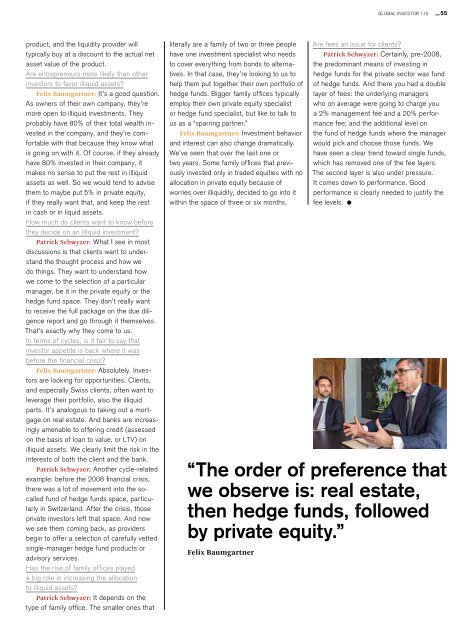Illiquid assets
Unwrapping alternative returns Global Investor, 01/2015 Credit Suisse
Unwrapping alternative returns
Global Investor, 01/2015
Credit Suisse
You also want an ePaper? Increase the reach of your titles
YUMPU automatically turns print PDFs into web optimized ePapers that Google loves.
GLOBAL INVESTOR 1.15 — 55<br />
product, and the liquidity provider will<br />
typically buy at a discount to the actual net<br />
asset value of the product.<br />
Are entrepreneurs more likely than other<br />
investors to favor illiquid <strong>assets</strong>?<br />
Felix Baumgartner: It’s a good question.<br />
As owners of their own company, they’re<br />
more open to illiquid investments. They<br />
probably have 80% of their total wealth invested<br />
in the company, and they’re comfortable<br />
with that because they know what<br />
is going on with it. Of course, if they already<br />
have 80% invested in their company, it<br />
makes no sense to put the rest in illiquid<br />
<strong>assets</strong> as well. So we would tend to advise<br />
them to maybe put 5% in private equity,<br />
if they really want that, and keep the rest<br />
in cash or in liquid <strong>assets</strong>.<br />
How much do clients want to know before<br />
they decide on an illiquid investment?<br />
Patrick Schwyzer: What I see in most<br />
discussions is that clients want to understand<br />
the thought process and how we<br />
do things. They want to understand how<br />
we come to the selection of a particular<br />
manager, be it in the private equity or the<br />
hedge fund space. They don’t really want<br />
to receive the full package on the due diligence<br />
report and go through it themselves.<br />
That’s exactly why they come to us.<br />
In terms of cycles, is it fair to say that<br />
investor appetite is back where it was<br />
before the financial crisis?<br />
Felix Baumgartner: Absolutely. Investors<br />
are looking for opportunities. Clients,<br />
and especially Swiss clients, often want to<br />
leverage their portfolio, also the illiquid<br />
parts. It’s analogous to taking out a mortgage<br />
on real estate. And banks are increasingly<br />
amenable to offering credit (assessed<br />
on the basis of loan to value, or LTV) on<br />
illiquid <strong>assets</strong>. We clearly limit the risk in the<br />
interests of both the client and the bank.<br />
Patrick Schwyzer: Another cycle- related<br />
example: before the 2008 financial crisis,<br />
there was a lot of movement into the socalled<br />
fund of hedge funds space, particularly<br />
in Switzerland. After the crisis, those<br />
private investors left that space. And now<br />
we see them coming back, as providers<br />
begin to offer a selection of carefully vetted<br />
single-manager hedge fund products or<br />
advisory services.<br />
Has the rise of family offices played<br />
a big role in increasing the allocation<br />
to illiquid <strong>assets</strong>?<br />
Patrick Schwyzer: It depends on the<br />
type of family office. The smaller ones that<br />
literally are a family of two or three people<br />
have one investment specialist who needs<br />
to cover everything from bonds to alternatives.<br />
In that case, they’re looking to us to<br />
help them put together their own portfolio of<br />
hedge funds. Bigger family offices typically<br />
employ their own private equity specialist<br />
or hedge fund specialist, but like to talk to<br />
us as a “sparring partner.”<br />
Felix Baumgartner: Investment behavior<br />
and interest can also change dramatically.<br />
We’ve seen that over the last one or<br />
two years. Some family offices that previously<br />
invested only in traded equities with no<br />
allocation in private equity because of<br />
worries over illiquidity, decided to go into it<br />
within the space of three or six months.<br />
Are fees an issue for clients?<br />
Patrick Schwyzer: Certainly, pre-2008,<br />
the predominant means of investing in<br />
hedge funds for the private sector was fund<br />
of hedge funds. And there you had a double<br />
layer of fees: the underlying managers<br />
who on average were going to charge you<br />
a 2% management fee and a 20% performance<br />
fee; and the additional level on<br />
the fund of hedge funds where the manager<br />
would pick and choose those funds. We<br />
have seen a clear trend toward single funds,<br />
which has removed one of the fee layers.<br />
The second layer is also under pressure.<br />
It comes down to performance. Good<br />
performance is clearly needed to justify the<br />
fee levels.<br />
“The order of preference that<br />
we observe is: real estate,<br />
then hedge funds, followed<br />
by private equity.”<br />
Felix Baumgartner

















